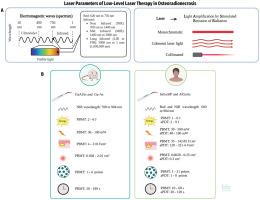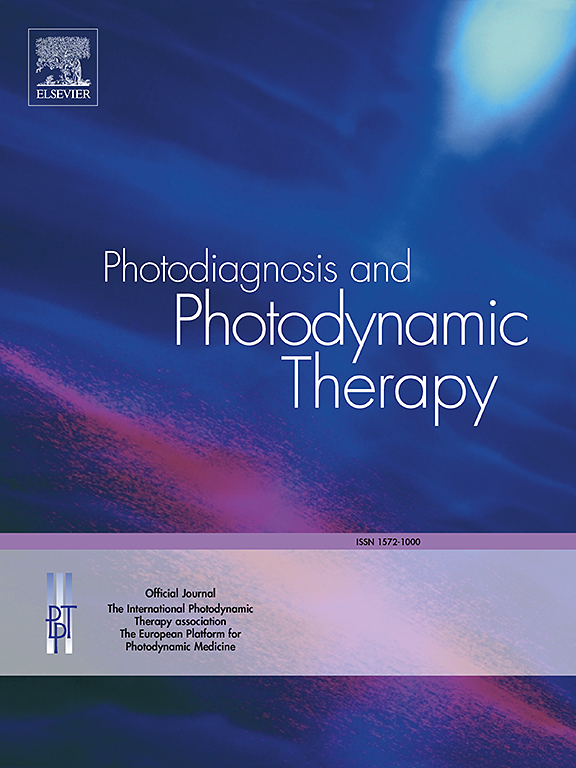Current trends and available evidence on low-level laser therapy for osteoradionecrosis: A scoping review
IF 3.1
3区 医学
Q2 ONCOLOGY
引用次数: 0
Abstract
Background
This scoping review explored current trends and available evidence in Low-Level Laser Therapy (LLLT) in the treatment and prevention of osteoradionecrosis.
Methods
The search strategy was conducted in MEDLINE/PubMed, EMBASE, Web of Science, and grey literature on January 15, 2024, without language or time restrictions.
Results
19 studies were included. The application of LLLT protocols was 58 % for therapeutic use, 21 % for preventive use, and 21 % for a combination of both. Regarding the use of antimicrobial photodynamic therapy (aPDT), 41 % of the studies employed this technique, which utilized methylene blue as the photosensitizer. For treatments associated with photobiomodulation, 57 % reported pharmacological treatment, 29 % surgical treatment, 11 % prescribed chlorhexidine mouthwashes, and 4 % other therapies. In vivo studies used diode lasers emitting low incident power densities in the near-infrared wavelength (67 %) at 780 to 904 nm. In comparison, case reports also used diode lasers emitting low incident power densities in the red and near-infrared wavelength (64 %) at 660 to 904 nm. The continuous emission mode was utilized in 83 % of in vivo studies and 17 % of the case reports. None of the studies included in this review reported all laser parameters.
Conclusions
In general, studies suggested that LLLT can be used for therapeutic and preventive applications in the management of osteoradionecrosis. However, clinical studies are case reports and the variability in laser parameters across the included studies poses challenges for establishing standardized treatment protocols. The lack of comprehensive data on laser parameters underscores the need for future research to focus on standardizing LLLT protocols and conducting well-designed, large-scale clinical trials. This approach will help to better evaluate the effectiveness of LLLT and potentially integrate it more reliably into clinical practice.

低强度激光治疗骨软化症的当前趋势和可用证据:范围综述。
背景:本综述探讨了低强度激光疗法(LLLT)在治疗和预防骨坏死方面的当前趋势和现有证据:检索策略:于 2024 年 1 月 15 日在 MEDLINE/PubMed、EMBASE、Web of Science 和灰色文献中进行检索,无语言和时间限制:结果:共纳入 19 项研究。LLLT方案的应用中,58%用于治疗,21%用于预防,21%用于两者的结合。关于抗菌光动力疗法(aPDT)的使用,41%的研究采用了这种利用亚甲基蓝作为光敏剂的技术。对于与光生物调节相关的治疗,57%的研究报告了药物治疗,29%的研究报告了手术治疗,11%的研究报告了洗必泰漱口水,4%的研究报告了其他疗法。体内研究使用的是入射功率密度较低的二极管激光器,波长在 780 到 904 纳米的近红外波段(67%)。相比之下,病例报告也使用了红外和近红外波长(64%)、660 至 904 纳米的低入射功率密度二极管激光器。83% 的体内研究和 17% 的病例报告采用了连续发射模式。本综述中没有一项研究报告了所有激光参数:总的来说,研究表明 LLLT 可用于治疗和预防骨软化症。然而,临床研究均为病例报告,且所纳入研究的激光参数存在差异,这给制定标准化治疗方案带来了挑战。缺乏有关激光参数的全面数据突出表明,未来的研究需要重点关注 LLLT 治疗方案的标准化以及开展设计良好的大规模临床试验。这种方法将有助于更好地评估 LLLT 的有效性,并有可能将其更可靠地融入临床实践中。
本文章由计算机程序翻译,如有差异,请以英文原文为准。
求助全文
约1分钟内获得全文
求助全文
来源期刊

Photodiagnosis and Photodynamic Therapy
ONCOLOGY-
CiteScore
5.80
自引率
24.20%
发文量
509
审稿时长
50 days
期刊介绍:
Photodiagnosis and Photodynamic Therapy is an international journal for the dissemination of scientific knowledge and clinical developments of Photodiagnosis and Photodynamic Therapy in all medical specialties. The journal publishes original articles, review articles, case presentations, "how-to-do-it" articles, Letters to the Editor, short communications and relevant images with short descriptions. All submitted material is subject to a strict peer-review process.
 求助内容:
求助内容: 应助结果提醒方式:
应助结果提醒方式:


